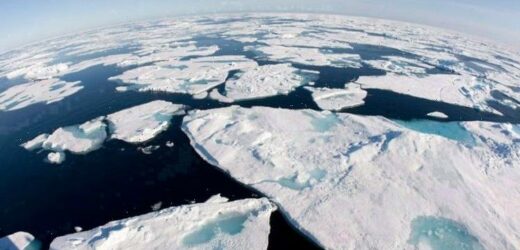Antarctica: 'Ancient remains' discovered in valley after ice melts
We use your sign-up to provide content in ways you’ve consented to and to improve our understanding of you. This may include adverts from us and 3rd parties based on our understanding. You can unsubscribe at any time. More info
Experts have long feared that polar ice melt, caused by global warming, will have a catastrophic effect on the planet. It has been linked to extreme weather events and rising sea temperatures. And now experts have discovered it is impacting the Earth’s crust – the thin but important zone where dry, hot rock from deep inside our world reacts with the water and oxygen of the surface.
Sophie Coulson, the lead author of a new study paper published in the journal Geophysical Research Letters, said: “Think of a wooden board floating on top of a tub of water.
“When you push the board down, you would have the water beneath moving down. If you pick it up, you’ll see the water moving vertically to fill that space.”
Known as the rebounding effect, it is said to be responsible for sea levels dropping in places like Scotland and Canada each year.
And this is also apparently happening to Earth’s crust as well.


But Ms Coulson said the experts were blown away by their recent findings.
She added: “Scientists have done a lot of work directly beneath ice sheets and glaciers.
“So they knew that it would define the region where the glaciers are, but they hadn’t realised that it was global in scale.”
The melting ice is causing the Earth to deform “even in spots more than 1,000 kilometers from the ice loss.”, according to the reports.
The new discovery by Ms Coulson’s team has found that in some places, the crust was moving more horizontally than it was vertically.

When the Laurentide Ice Sheet melted away into the sea, Canada and Alaska were no longer weighed down by the ice and the southern US was no longer pushed up as a result.
Now, the land around Canada’s Hudson Bay has started rising about half an inch every year while in Washington DC there has been a shocking prediction the US capitol could be completely underwater by 2200.
She said: “In some parts of Antarctica, for example, the rebounding of the crust is changing the slope of the bedrock under the ice sheet, and that can affect the ice dynamics.
“On recent timescales, we think of the Earth as an elastic structure, like a rubber band, whereas on timescales of thousands of years, the Earth acts more like a very slow-moving fluid.
DON’T MISS
EU considers investing in UK’s Galileo replacement [REVEAL]
Elon Musk ‘interested’ in UK Tesla factory after snubbing Russia [INSIGHT]
Russia threatens ‘Asian NATO’ in fury over AUKUS deal [REPORT]


“Ice age processes take a really, really long time to play out, and therefore we can still see the results of them today.”
Ms Coulson also explained that this new discovery will help to inform climate experts with their analysis of glacier melt, ice loss and rising global temperatures and its impacts in the future.
She said: “For example, to accurately observe tectonic motions and earthquake activity, we need to be able to separate out this motion generated by modern-day ice-mass loss.”
It comes after the UN released its IPCC report on climate change that issued a “code red” for humanity and urged the international community to take immediate action to prevent climate catastrophe.
Source: Read Full Article


